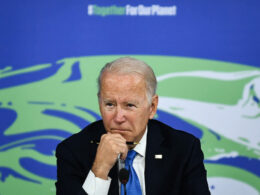By Eric Byl, ISA International Executive
There is much to say about the so-called “post-pandemic” economic rebound. The figures look impressive, but warnings are manifold. New heights in inequality between rich and poor are pouring petrol on existing social tensions and producing new ones. Spiraling food prices are provoking further social explosions. Capitalism’s disastrously slow, uneven and inefficient vaccine rollout leads to more contagious and vaccine-resistant brands of the virus. Inflationary pressures could force central banks to tighten monetary policy and plunge the economy back into recession. Moreover, there are the many challenges that already existed before the pandemic and have become bigger, more imminent, and more urgent: ecological tipping points, the new Cold War, the accumulation of debt, lack of investment in productive capacity etc.
No wonder then that the International Monetary Fund (IMF) warns that risks around its ‘global baseline’ forecast- 6% global growth in 2021 and 4.9% in 2022 — could reduce those figures. Its lack of confidence is also revealed by its appeal to central banks not to tighten monetary policy unless persistent inflation forces them to do so.
Growth figures look impressive, but they must be put in context. They come after a 3.2% contraction in the world economy in 2020, the worst since WWII. This growth is also driven by historic shifts in capitalist economic policy, with massive monetary (money creation) and fiscal (budget spending) interventions amounting to 16% of GDP on average in the advanced capitalist countries (27% if loans, equity and guarantees are included). Corresponding figures for “emerging” and low-income countries were 4 — 6.5% and 1.5 — 2% of GDP respectively. According to the IMF, as of early July 2021, no less than $16,500 billion had been spent by governments worldwide to fight the pandemic. With this in mind, the IMF’s growth figures are actually disappointing.
It looks as if the advanced capitalist countries’ economies will reach pre-crisis GDP levels sooner than anticipated. China did so last year and the US during the first quarter of this year. Eurozone GDP is still 3% below pre-crisis levels but its growth has now for the first time outpaced China and the US. It could catch up by the end of this year, with France expected to grow by 6%, Italy by 5%, Romania by 7.4% and Germany, more affected than other European countries by shortages of intermediate materials, by 3.6%. According to the IMF, growth in the advanced capitalist countries will have made up for all pandemic-related losses by the end of 2022. That is if new Covid-19 variants are kept under control. We already saw how when Morgan Chase lowered its third-quarter growth forecast for China from 5.8% to 2.3% because of the ‘Delta’ variant, shockwaves were sent through the US stock market.
Fault lines deepening global inequality
In the “emerging” economies, it will take much longer to catch up and even more so in low-income countries. So much so that the IMF warns that the vaccine ‘access fault line’ will split the global recovery in two and recognizes that close to 80 million more people are expected to enter extreme poverty in 2020–21 compared with pre-pandemic projections. According to the IMF, low-income countries will require at least an additional $200 billion in spending to combat the pandemic and another $250 billion to regain their pre-pandemic path of economic growth.
While 40% of the population in advanced economies has been fully vaccinated, that number is less than half that in “emerging” economies and only 2% in low-income countries. Sizable fiscal interventions in the advanced economies as compared to emerging and low-income countries have also further widened the wealth gap. Concerns over this reality led the IMF to create new money, through so-called “special drawing rights”, to the tune of $650 billion. However, over 50% of this will go to the advanced economies with 42% to emerging economies and a mere 3,2% to low-income countries. It will, however, increase the reserves held by Argentina, Pakistan, Ecuador and Turkey by at least 10%. Though packaged in nice words, this policy’s poorly disguised main purpose is an attempt to bolster financial stability by saving private and public investors/speculators from suffering losses as a result of more sovereign defaults on public debt.
The threat of inflation
In the meantime, global recovery has pushed up oil prices almost 70% above their low base in 2020, non-oil commodity prices rose by close to 30%, especially metal and food prices because of shortages. This in itself is a source of social unrest, especially on top of the raging pandemic, as we have seen in Tunisia, South Africa and Cuba. Currency depreciation also lifted the price of imports, further adding to inflation. Some ‘emerging’ countries, including Brazil, Hungary, Mexico, Russia, and Turkey, have already been forced to start tightening their monetary policy to counter upward price pressures.
In the advanced capitalist countries, recovery has come at the expense of an increase in public debt by 20% on average and more than a tripling of budget deficits as well as gigantic expansions of central bank balances. Together with Biden’s two major spending packages, this has raised questions about whether economies might “overheat” and inflation run out of control. In the US, the consumer price index jumped by 5.4% in June after a 5% rise in May. The producer price index was up 7.3% in June, a 13-year record. Demand is surging as the economies open up, while many companies lack the supplies to fulfill demand. The end of rent and mortgage moratoriums in the US as well as the end of a VAT reduction in Germany further fuel these inflationary pressures. Price rises put pressure on the living standards of the working class and poor households.
At this stage the IMF, central banks and most mainstream economists consider this surge in inflation to be a temporary phenomenon that will recede to pre-pandemic levels in 2022. This is based on their estimation that labor market slack remains substantial even though some sectors are suffering from shortages and hiring difficulties. They think inflationary trends are based on temporary factors and that other structural factors, such as automation, have reduced price sensitivity.
Neoliberal and Keynesian theories of inflation
In other words, mainstream economists have ditched the one-sided and basic thesis of monetarism (a concept central to the ideas of “neoliberalism”), that money supply drives prices of goods and services and that inflation arises when money supply rises faster than production. In fact during 2020 money supply rose by over 25% but most of it has been hoarded or used for speculation. As a consequence, the huge rise in money supply was largely offset by the fall in money circulation (velocity) and thus prices of goods and services did not reflect the huge money creation at that stage.
The alternative mainstream theory of inflation is the Keynesian “cost-push” thesis. This asserts that inflation is wage-driven, the result of low unemployment and high demand for labour relative to supply forcing up wages which in turn forces up prices, the so-called wage-price spiral. Often Keynesians refer to the “Phillips curve” which argues that high unemployment leads prices to deflate while low unemployment leads to inflation. However in the 1970s, as opposed to the Phillips Curve, both inflation and unemployment rose simultaneously, which was then called ‘stagflation’. After the 2008/9 recession, unemployment in the major economies dropped to historic lows while wage rises remained low as did price inflation.
Marxism, value and inflation
Marx never formulated a comprehensive theory of inflation. He argued that money represents “exchange value”, or the amount of labour required to produce goods and services. It is not money supply that drives prices, but ultimately the other way around. This is not to deny that supply and demand, the formation of cartels, class struggle etc, interfere with pricing, but the fundamental factor that determines prices is the average quantity of socially necessary labour time required for the production and processing of goods and services. Other factors can push prices under or above real (exchange) value, but always temporarily.
Marx also rejected the idea that wage rises are the cause of inflation. In Value, Price and Profit he argued
“a struggle for a rise of wages follows only in the track of previous changes, and is the necessary offspring of previous changes in the amount of production, the productive powers of labour, the value of labour, the value of money, the extent or the intensity of labour extracted, the fluctuations of market prices, dependent upon the fluctuations of demand and supply, and consistent with the different phases of the industrial cycle; in one word, as reactions of labour against the previous action of capital. By treating the struggle for a rise of wages independently of all these circumstances, by looking only upon the change of wages, and overlooking all other changes from which they emanate, you proceed from a false premise in order to arrive at false conclusions.”
Contrary to the different “economic schools” of capitalism, Marx didn’t single out one or a few symptomatic characteristics (Money supply, wage costs,…) turning them into the root cause of everything, but approached the economy as a global interplay of contradictory forces.
In its World Economic Update, the IMF seems to unwittingly confirm this. They point to the fact that wage growth is broadly stable so far, and that despite a recent uptick in wage growth in the US, the wages of individuals do not indicate broader pressure in the labor market and that data from Canada, Spain and the UK show similar patterns of broadly stable wage growth. In other words, if there is any “cost-push” at this stage, it is not from wages, but from companies hiking prices, partly due to a rising cost of raw materials, commodities and other elements, partly due to disruption from Covid, and partly as an attempt to increase profits. If we look at it from a broader perspective, labour’s share of GDP in advanced capitalist countries has been shrinking for decades. In the US it has shrunk from an average of 63% in the 1950s and 60s to 57% in the past decade. So wages cannot be held responsible for price hikes. Indeed if wages had remained at the same level since the 1960s, collectively US workers would have earned an extra trillion dollars each year.
The IMF refers to the process of automation as an essentially deflationary factor, or in its words, a “price-sensitivity reducing” factor. Marx explained this more clearly and extensively. He pointed to the fact that capitalists, to outcompete their competitors, use “surplus value” (essentially the unpaid labor of workers taken as profits by bosses) to increase productivity by installing better and more efficient technologies. As a result, the required labor time per unit of production tends to fall. So while the supply of goods and services tends to rise, the real value — the amount of average labor spent in production — of each commodity or service will fall alongside a rise in the productivity of labor. That explains why there is an inherent tendency for prices of commodities to fall, not to rise. Capitalists try to counteract this trend and its impact on the rate of profit by increased exploitation of workers and by monetary means.
For workers, falling prices or deflation boosts their buying power and savings, but for capitalists, it eats into their profits, makes debt repayment harder, and makes productive investments less attractive. They consider controlled inflation ‘healthy’ as it increases profits, renders debt repayment more bearable, erodes wages and stimulates consumption. Recently Kenneth Rogoff, former IMF chief economist, called ‘a little inflation no bad thing’. He argues that after the financial crisis in 2008 central banks should have adopted negative interest rates and allowed for 4–6% inflation for a few years. He now argues in favor of a 3% inflation target (instead of the Fed’s 2%) and quotes favorably his predecessor Olivier Blanchard who pleaded in 2010 for inflation targets to be raised to 4%.
Inflation is difficult to manage
“Healthy” inflation is understood to be a rate that is slightly above the combined rates of growth in productivity and the workforce. Until the mid to late 1970s in the advanced capitalist countries, 4% was considered healthy, later when productivity growth slowed down, 2% became the generally agreed inflation target. Kenneth Rogoff is actually arguing to broaden the margin between inflation and productivity increases in the hope that this will not only reduce the debt burden and increase demand but also stimulate production. The problem is that inflation is difficult to manage.
Over the past 20 years, central banks failed to achieve their 2% target partly because they feared a repetition of the early to 1970s when they completely lost control, resulting in what was then called a stagflation trap, economic stagnation combined with double-digit or galloping inflation. It required a combination of brutal attacks on the workers’ movement and a strong brake on money supply (which provoked another recession) for the capitalists to find a way out. Thatcher in the UK increased real interest rates between 1979 and 1982 from -3% to 4% and unemployment soared from 5% to 11% in 1983. Volcker, then the chair of the US Fed in the US, increased real interest rates from negative rates to 5%, and unemployment doubled to 10% in 3 years’ time, but inflation decreased from 13% to 3%. Neoliberalism then became the dominant policy for a whole historical era.
That is, as we have pointed out previously, no longer tenable. In today’s crisis, the capitalists and their representatives in the central banks and governments had no other option than to resort to more interventionist measures. They didn’t like it, but it was necessary to avoid an even greater economic disaster that could have threatened their system. But they do so with the specter of losing control in the back of their minds.
Goods and services, including productive goods (machinery, raw materials, factories and offices) are generally sold once or only a few times for consumption and quickly exit circulation. They are rarely hoarded and their velocity — the number of times they enter and leave circulation — is limited, easy to trace and control. That is not the case with money. The same amount of money can enter and leave circulation many times, jump from owner to owner or simply be hoarded and not circulate at all. With money supply, velocity is a much more capricious factor, hoarding can stop money from entering circulation, but when activity picks up and money starts to roll, its “multiplier effect” can easily become exponential.
This is what Nouriel Roubini, alias Dr. Doom, warns of, in relation to inflation. It is difficult to take a firm view. At this stage, deflationary trends still seem to be more dominant, but the economy is walking a tightrope and there are many factors that could tip the balance in one or the other direction. Roubini points to the obvious: debt ratios today are almost three times higher than in the 1970s and loose money supply combined with supply shocks could trigger inflation, on the other hand, debt servicing is still relatively cheap as interest rates are historically low and kept low by central banks.
Loose money supply has however fueled asset and credit bubbles with high price-to-earnings ratios, low-risk premiums and inflated tech assets. It has also further stimulated irrational crypto-mania, high-yield corporate debt, meme stocks (stocks that see sudden and dramatic changes due to social media hype), etc. That can culminate in what economists call a Minsky moment, a sudden loss of confidence, and lead to panic triggering a crash.
A decade ago, food prices spiraled out of control as speculators flooded the futures market. This led to food riots and was an important element in what became the so-called Arab spring. A repetition of such a scenario, especially in a period of shortage creating many speculative opportunities, is perfectly imaginable, but the effects of it would be even more disastrous in the context of climate disasters, overpriced financial markets and a raging pandemic.
There is also talk of ‘housing fever’ as property prices surged by 9.4% across OECD countries in the first quarter of 2021. In the US in April, house prices reached their fastest growth in 30 years. Low borrowing costs, supply shortages, rising building prices and well-off people looking for larger properties have driven this. House prices are growing at a far faster rate than earnings, further adding to inequality. Fannie Mae, the US federal housing association, argues that bigger mortgages will feed into higher rents and push up general inflation.
Catch 22
If inflation were to rise more in the medium or longer-term, central banks would find themselves in a catch 22 situation: inflation could go double-digit if they continue their loose money supply policy and end up in a stagflation trap. In countries holding public debt mainly in domestic currency, public debt will at first become more bearable. In countries with public debts denominated in foreign currency (including many of the most indebted countries in Africa and Latin America) that would not be the case and an increasing number of those countries would be at risk of default and need to restructure their debts. It could provoke a chain of defaults, which would add to international tensions and drive protectionism.
Private debts would also see their spreads spike in relation to safer government bonds and rising inflation would grow inflation risk premiums. About a fifth of US companies and even more so in Europe are considered zombie companies, meaning that they would be unable to service their debts if it weren’t for access to cheap money. If this source would dry up many of them would go bust and pull with them a chain of bankruptcies.
However, if central banks were to scale back their interventions and raise interest rates to fight inflation, a massive debt crisis, a chain of defaults and bankruptcies and a deep recession would be around the corner. That’s why the IMF warns against premature monetary tightening. It is now acknowledged that the European Central Bank made a major mistake when it raised interest rates too soon after the 2008/9 recession. It has recently reviewed its policy from an inflation target of 2% or below to a policy that accepts that inflation can rise moderately above this target for a period. This can be interpreted as a play of words, but it is actually a major shift away from the founding principles of the ECB and from the German Bundesbank’s idea of price stability as the top priority. This principle was defended steadfastly by the German establishment, even at the expense of imposing a 25% contraction on Greece’s economy after the 2008/9 great recession, which caused immeasurable hardship for its population. It is no exaggeration to say that this policy significantly contributed to the unpreparedness of Greek fire-fighting services to deal with the deadly fires which wreaked havoc there recently.
The US Fed seems to be ahead of ECB in declaring “a policy that makes up for the past failure to reach the inflation target”, meaning the Fed will actively seek to drive inflation above its target. While this is not the declared intent of the ECB and would definitely provoke major disagreements, especially with the Bundesbank, we can nevertheless expect its policy not to be that far apart from the Fed’s if the euro area is hit by similar shocks.
Kicking the can further down the road
The most likely scenario is for central banks and governments to continue with looser policies, though perhaps of a more targeted nature and with the intent of tapering them down over time, but very carefully and probably not without regular disagreements and U-turns. This is because it will have to be done under extremely difficult circumstances. Logically, the pandemic should have given way to more international cooperation, but capitalism completely failed. PPE, tests and ventilators were weaponized to further national interests and then we saw the appearance of “vaccine diplomacy” and “vaccine imperialism”. The trends towards protectionism were not reversed but strengthened. National governments were pushed to seek greater self-reliance. Further supply shocks as a result of protectionism which stimulate inflation have not become less, but more likely to occur.
This will be compounded by an aging population in the advanced and emerging economies as well as more stringent immigration restrictions, especially as a growing number of low-income countries will be faced with health catastrophes, economic implosion, wars and civil wars as well as climate disaster. The rivalry between the US and Chinese imperialism over world hegemony has turned into an all-out cold war, which could at times turn hot. Alliances will be unstable with some lesser powers utilizing the stalemate between the two dominant imperialist forces to realize their own regional imperialist ambitions. A less secure and more unstable world is lying ahead threatening to fragment the global economy and make supply chains more unreliable with further shocks ahead.
While there is a certain recognition for the need for a green transition, Biden’s infrastructure plan has little to do with this and is mainly aimed at not being overtaken by China. Tech and cyber-wars are already well underway. There is no chance whatsoever that the recent IPCC climate change report will do what the pandemic failed to do: act as a wake-up call to convince capitalists globally to put aside their national interests for international cooperation. No capitalist will voluntarily give up polluting unless they are well compensated for it with public funds which will ultimately be paid for by workers and their families. Climate challenge requires the free exchange of knowledge and technology, international cooperation, democratic planning and massive plans of public investment in a green transition. Private interests and profiteering, key ingredients of a market economy, cannot contribute to this solution, but are the major obstacle standing in its way.
One cannot conclude firmly whether the deflationary trend, which is still dominant today, will be strong enough to push back inflationary pressures in the advanced capitalist countries. There are too many loopholes that could shift the balance. If inflation goes into double digits it will provoke mass resistance. Consider the “yellow vests” movement in France in 2018 as an appetizer. But even if the capitalists manage to rein in the immediate threat of an inflationary crisis, it won’t solve any of the major underlying systemic problems either. Demands over working conditions and wages, as well as movements opposing oppression and on the climate catastrophe will still develop
One thing is for sure, the illusion that decisions can be left to the wisdom of the market and reducing central banks’ and governments’ roles to act merely as technocrats ‘managing’ society belongs to the past. The idea of central banks’ “independence” dates from another era and governments will be forced, whether they want to or not, to continue with more interventionist policies. It won’t be possible anymore for the establishment to claim that society has overcome all ideology and running it is merely a question of smart technicians.
On the contrary, politics will reassert its primacy and with it ideological struggle over political choices will flourish. Times will be difficult for the political “centre” as polarization will increase. The false illusion of being neither left nor right, which has always ultimately meant that one basically accepted the existing right-wing policy, will dissipate. Major problems, unsolvable within the framework of capitalist society, will stimulate the search for more radical solutions. Right-wing populist forces will try to exploit this. It would be an illusion to think this can be answered by left-wing reformism or “populism”. Only a serious attitude to analysis, perspectives, programme and organisation can offer a socialist internationalist way out of capitalism’s decay.












